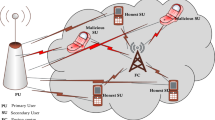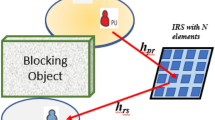Abstract
Cognitive radio is a promising technology for alleviating the spectrum shortage problem which is caused by current fixed spectrum allocation policy. With a smart antenna configured in a secondary user, this paper proposes a new spectrum sensing algorithm exploiting the correlation of channel gains between antenna elements. The proposed method detects the primary user signal with the test-statistics based on antenna correlation. Compared to available antenna correlation based spectrum sensing algorithm, the proposed algorithm can determine easily the decision threshold level for achieving required false alarm probability under given number of samples, and achieves a better performance. Finally, the proposed algorithm is verified by numerical simulation.
Similar content being viewed by others
References
Spectrum policy task force report, E.D.N. 02-135, Federal Communication Commission, Technical Report, Washington, DC, Nov. 2002.
Akyildiz I. F., Lee W.-Y., Vuran M. C., Mohanty S. (2008) A survey on spectrum management in cognitive radio. IEEE Communications Magazine 46(4): 40–48
Cabric, D., Mishra, M., & Brodersen, R. W. (2004). Implementation issues in spectrum sensing for cognitive radios. In Proceedings of 36th Asilomar conference on signals, systems and computers (Vol. 1, pp. 772–776).
Sahai, A., Hoven, N., & Tandra, R. (2004). Some fundamental limits on cognitive radio. In Proceedings of 42nd Allerton conference on communication, control and computing.
Zeng, Y., Koh, C. L., & Liang, Y. C. (2008). Maximum eigenvalue detection: Theory and application. In Proceedings of IEEE ICC (pp. 4160–4164). Beijing, China.
Zeng, Y. & Liang, Y. C. (2007). Covariance based signal detections for cognitive radio. In Proceedings of IEEE DySPAN (pp. 202–207). Dublin, Ireland.
Oh, D. C., Lee, J. H., & Lee, Y. H. (2010). Spectrum sensing based on antenna correlation in cognitive radio systems. Wireless Personal Communications, doi:10.1007/s11277-010-0161-y.
Durgin, G. D., & Rappaport, T. S. (1999). Effects of multipath angular spread on the spatial cross-correlation of received voltage envelopes. In Proceedings of IEEE 49th Conference on Vehicular Technology (Vol. 2, pp. 996–1000).
Rosenberg L. (1965) Nonnormality of linear combination of normally distributed random variables. American Mathematical Monthly 72(10): 888–890
Rahman, N. A. (1968). A Course in theoretical statistics. Charles Griffin and Company. New York.
Author information
Authors and Affiliations
Corresponding author
Rights and permissions
About this article
Cite this article
Jin, M., Li, Y., Zhang, Z. et al. A New Spectrum Sensing Algorithm Based on Antenna Correlation for Cognitive Radio Systems. Wireless Pers Commun 66, 419–428 (2012). https://doi.org/10.1007/s11277-011-0349-9
Published:
Issue Date:
DOI: https://doi.org/10.1007/s11277-011-0349-9




